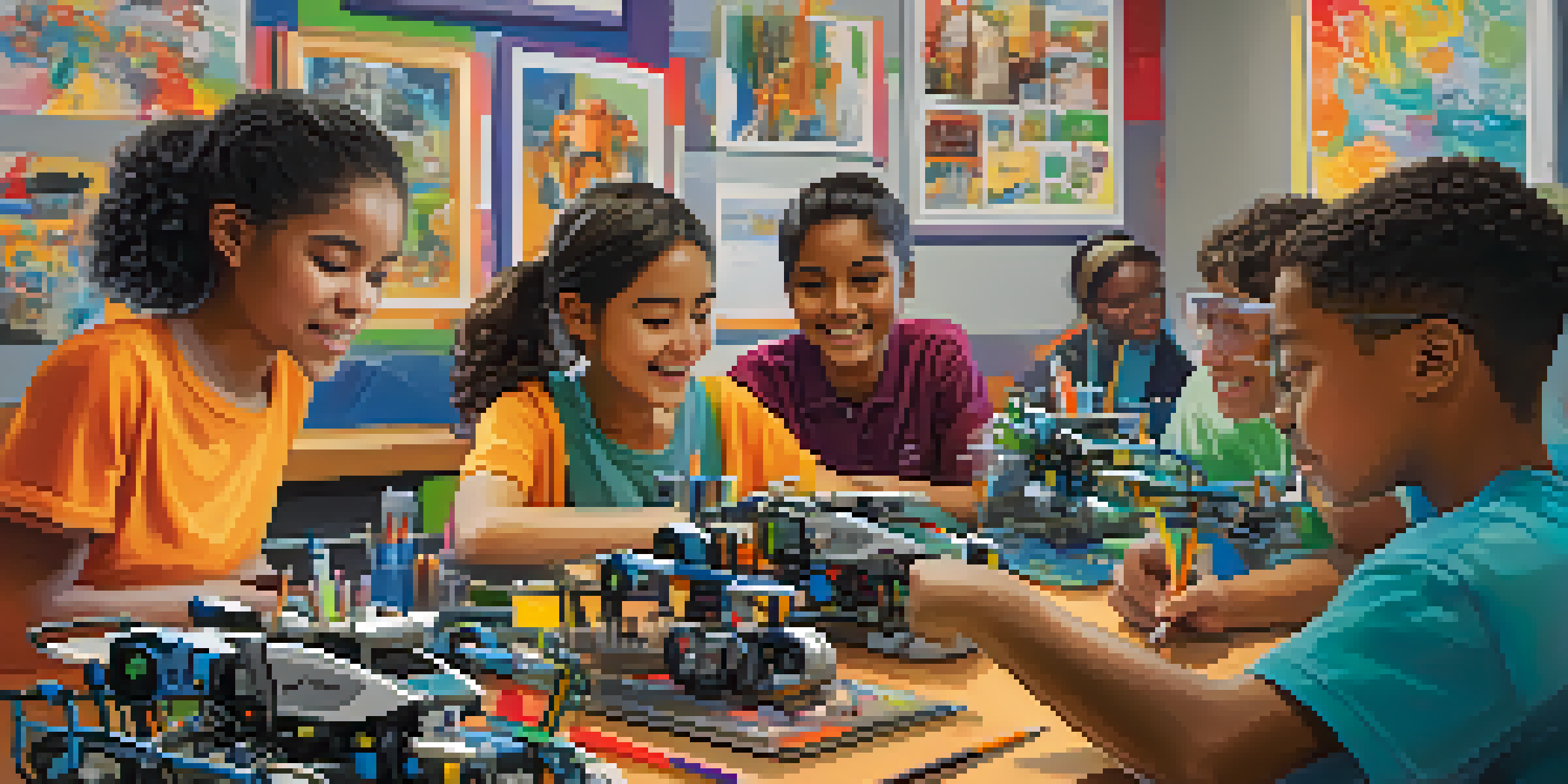Exploring the Link Between STEAM and Emotional Intelligence

Understanding STEAM: A Holistic Approach to Learning
STEAM, which stands for Science, Technology, Engineering, Arts, and Mathematics, represents an integrated approach to education. This method emphasizes creativity alongside technical skills, encouraging students to think critically and innovatively. By merging these disciplines, STEAM prepares learners for a rapidly evolving world that values both analytical and creative problem-solving.
Emotional intelligence is the key to both personal and professional success.
The inclusion of the Arts in STEAM is particularly significant, as it nurtures creative thinking and emotional expression. This balance helps students develop a well-rounded skill set, making them not just proficient in technical subjects but also adept at navigating the complexities of human interactions. Understanding this synergy is key to appreciating how STEAM can foster emotional intelligence.
Ultimately, STEAM is about more than just academic knowledge; it’s about preparing students for real-world challenges. By cultivating a blend of technical and emotional skills, educators can help learners become more adaptable and empathetic individuals. This is where the link between STEAM and emotional intelligence truly begins to take shape.
What is Emotional Intelligence and Why It Matters
Emotional intelligence (EI) refers to the ability to recognize, understand, and manage our emotions while also being aware of the emotions of others. This skill is crucial in both personal and professional settings, as it enhances communication, collaboration, and conflict resolution. In a world that increasingly values soft skills, emotional intelligence has become a key differentiator for success.

Research has shown that individuals with high emotional intelligence tend to perform better in team environments. They are more likely to take initiative, demonstrate leadership, and create a positive atmosphere that fosters collaboration. This is especially relevant in STEAM fields, where teamwork and diverse perspectives are essential for innovation.
STEAM Merges Creativity and Skills
STEAM education integrates Science, Technology, Engineering, Arts, and Mathematics to foster both analytical and creative problem-solving skills.
By integrating emotional intelligence training into education, we equip students with the tools they need to navigate interpersonal dynamics effectively. As they learn to empathize and communicate, they become not only better learners but also better leaders. This foundation of emotional intelligence can lead to a more fulfilling professional life and healthier relationships.
The Intersection of STEAM and Emotional Intelligence
The intersection of STEAM and emotional intelligence is a rich and fertile ground for developing well-rounded individuals. Projects that require collaboration, such as group science experiments or art installations, naturally encourage students to engage with one another emotionally. This environment nurtures their ability to express feelings, listen actively, and respond appropriately to the emotions of their peers.
Creativity is thinking outside the box, and emotional intelligence is knowing how to work with others to turn those ideas into reality.
For instance, a team of students working on a robotics project must not only apply their technical skills but also communicate effectively to troubleshoot issues together. This requires emotional awareness and empathy as they navigate differing opinions and stress. Such experiences are invaluable, as they mirror real-world situations where strong emotional intelligence is essential for success.
By fostering emotional intelligence within STEAM education, we prepare students to tackle both technical challenges and interpersonal relationships. This dual focus enriches the learning experience and creates individuals who are not just competent but also compassionate leaders ready to contribute positively to society.
How Arts Facilitate Emotional Awareness in STEAM
The incorporation of the Arts in STEAM plays a vital role in enhancing emotional awareness among students. Engaging in artistic activities encourages self-expression and reflection, allowing learners to explore their emotions and understand those of others. This creative outlet is essential for developing empathy, as it enables students to see the world from different perspectives.
For example, a drama class might require students to portray various characters, prompting them to step into someone else's shoes. This kind of role-playing helps students practice empathy in a safe environment, reinforcing the emotional skills necessary for collaboration in STEAM projects. The ability to understand diverse viewpoints is crucial for innovation and problem-solving.
Emotional Intelligence Enhances Learning
Emotional intelligence is crucial for effective communication and collaboration, making it a key component in both personal and professional success.
Moreover, art serves as a bridge between technical skills and emotional intelligence, making learning more relatable and enjoyable. When students engage with both art and science, they cultivate a more profound sense of curiosity and a deeper understanding of the human experience. This holistic approach ultimately enhances their emotional intelligence, essential for their future careers.
Building Collaborative Skills Through STEAM Projects
Collaboration is at the heart of both emotional intelligence and STEAM education. Students participating in group projects learn to communicate effectively, share responsibility, and manage conflicts—skills that are integral to developing emotional intelligence. These experiences not only enhance their academic performance but also prepare them for future teamwork in the workplace.
For instance, working on a group engineering challenge requires students to brainstorm, delegate tasks, and provide constructive feedback to one another. This collaborative process fosters trust and respect among team members, which are crucial components of emotional intelligence. As they navigate these dynamics, students learn the importance of emotional regulation and active listening.
Ultimately, collaborative STEAM projects create a safe space for students to practice and refine their emotional intelligence skills. By emphasizing teamwork and mutual respect, educators can cultivate environments where emotional growth is as important as academic achievement. This prepares students to thrive in diverse environments, both in their careers and personal lives.
The Role of Educators in Promoting EI in STEAM
Educators play a pivotal role in fostering emotional intelligence within the context of STEAM education. By modeling emotional awareness and encouraging open communication, teachers can create a supportive atmosphere that values both emotional and intellectual growth. This guidance is crucial for helping students recognize and develop their emotional skills.
Incorporating activities that promote emotional intelligence—such as reflection exercises, peer feedback sessions, and group discussions—can enhance the learning experience. Educators can also facilitate workshops or projects that emphasize the importance of empathy, helping students learn to navigate their emotions and those of others effectively. This proactive approach sets the stage for lasting emotional development.
Collaboration Builds Essential Skills
Through collaborative STEAM projects, students develop emotional intelligence skills such as empathy, active listening, and conflict management.
Furthermore, by integrating emotional intelligence training into the curriculum, educators equip students with essential life skills that extend beyond the classroom. This not only enriches their academic journey but also cultivates a generation of compassionate, empathetic leaders. Ultimately, the role of educators is to inspire students to blend technical proficiency with emotional intelligence, ensuring their success in all aspects of life.
Future Implications: STEAM and EI in a Changing World
As we look towards the future, the integration of STEAM and emotional intelligence will become increasingly important in a rapidly changing world. The demand for individuals who can navigate both technical challenges and interpersonal dynamics will only grow. By emphasizing this dual focus in education, we prepare students for diverse career paths in an interconnected society.
Moreover, as technology continues to evolve, the need for emotional intelligence in the workplace will become even more pronounced. Jobs will require not only technical expertise but also the ability to collaborate, communicate, and understand the emotional needs of clients and colleagues. This shift highlights the necessity of incorporating emotional intelligence training alongside STEAM curricula.

In conclusion, exploring the link between STEAM and emotional intelligence equips students with a comprehensive skill set that prepares them for future challenges. By fostering creativity, collaboration, and emotional awareness, we can cultivate a generation of innovators and empathetic leaders who are ready to make a positive impact in the world.